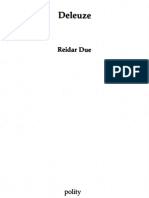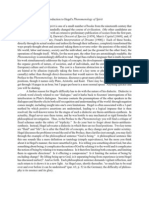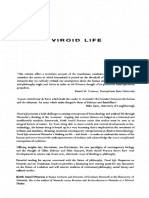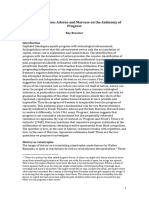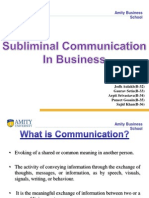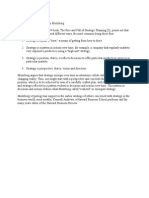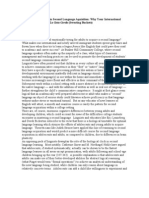Sloterdijk, Nerness and Dasein
Sloterdijk, Nerness and Dasein
Uploaded by
Antonio CamposCopyright:
Available Formats
Sloterdijk, Nerness and Dasein
Sloterdijk, Nerness and Dasein
Uploaded by
Antonio CamposCopyright
Available Formats
Share this document
Did you find this document useful?
Is this content inappropriate?
Copyright:
Available Formats
Sloterdijk, Nerness and Dasein
Sloterdijk, Nerness and Dasein
Uploaded by
Antonio CamposCopyright:
Available Formats
Article
Theory, Culture & Society
29(4/5) 36–42
Nearness and Da-sein: ! The Author(s) 2012
Reprints and permissions:
The Spatiality of Being sagepub.co.uk/journalsPermissions.nav
DOI: 10.1177/0263276412448828
and Time tcs.sagepub.com
Peter Sloterdijk
University of Art and Design, Karlsruhe, Germany
Abstract
This paper focuses on the latent spatial philosophy in Heidegger’s ‘Being and Time’,
highlighting a key aspect of the Heideggerian oeuvre that has mostly been overlooked
by commentators. It outlines the concept of an original spatiality of being that is
opposed to the philosophies of space in both physics and Cartesian metaphysics.
Through an elaboration of the essentially relational character of Da-sein, it is argued
that Heidegger’s vocabulary in ‘Being and Time’ yields an onto-topology that shows
Da-sein’s primary spatial embeddedness in the world. Finally, the paper argues that
Heidegger’s concept of spatiality remained cursory due to its residual existentialist
focus. In this context, it attempts a re-evaluation of its intellectual trajectory within
the realm of the Spheres project.
Keywords
Heidegger, space, spatiality, Da-sein, Sloterdijk, spheres, Spheres project
An essential tendency toward nearness lies in Da-sein. (Heiddegger,
1996: 98)
Only very few commentators on Heidegger have noted the nascent but
revolutionary treatise on being and space that underlies the sensationally
programmatic study of Being and Time. Under the spell of Heidegger’s
existential analytic of time, it has mostly been overlooked that the former
is grounded in a corresponding analytic of space and that both are fun-
damentally rooted in an analysis of movement. Therefore, we can find
entire libraries filled with studies of Heidegger’s onto-chronology, his
doctrines of Temporalizing (Zeitigung) and Historicity and read various
Corresponding author:
Peter Sloterdijk, University of Art and Design, Karlsruhe, Germany
Email: rektorat@hfg-karlsruhe.de
http://www.sagepub.net/tcs/
Downloaded from tcs.sagepub.com by guest on January 31, 2013
Sloterdijk 37
treatises on his philosophy of movement, or onto-kinesis. Concerning his
attempts at a theory of an originary ‘making-room’ (Einräumen) of space
or onto-topology, however, we find nothing but scattered, unciteable and
pietistic paraphrases.
Heidegger’s analysis positively delineates the spatiality of Da-sein as
Approaching (Näherung) and Orientation (Orientierung) through two
destructive steps. The spatial concepts of both, ‘vulgar’ physics as well
as metaphysics, must effectively be cleared away before the existential
analytic of Being-in (In-Sein) can be elaborated.
What does being-in mean? Initially, we supplement the expression
being-in with the phrase ‘in the world,’ and are inclined to under-
stand this being-in as ‘being-in something.’ With this term, the kind
of being of a being is named which is ‘in’ something else, as water is
‘in’ the glass, the dress is ‘in’ the closet.. . . Water and glass, dress
and closet, are both ‘in’ space ‘at’ a location in the same way. This
relation of being can be expanded; that is, the bench in the lecture
hall, the lecture hall in the university, the university in the city, and
so on until: the bench in ‘world space.’ These beings whose being
‘in’ one another can be determined in this way all have the same
kind of being-that of being objectively present-as things occurring
‘within’ the world. . . . In contrast, being-in designates a constitution
of being of Da-sein, and is an existential. But we cannot understand
by this the objective presence of a material thing (the human body)
‘in’ a being objectively present. . . . ‘In’ stems from innan-, to live,
habitare, to dwell. ‘An’ means I am used to, familiar with, I take
care of something. It has the meaning of colo in the sense of habito
and diligo. . . . Being as the infinitive of ‘I am’: that is, understood
as an existential, means to dwell near . . . to be familiar with. (1996:
50–51)
By alluding to the Old German verb innan, to inhabit, Heidegger
quickly reveals the crux of the existential analytic of spatiality. What
he calls being-in-the-world means nothing other than to ‘inn’ the world
in the verbal-transitive sense: to dwell in the world and to enjoy its open-
ness through an initial attunement (Einstimmung) and expansion
(Ausgriff). Because Da-sein is always already a completed act of inhabit-
ing – the result of a primal leap into dwelling – spatiality and existence
are inseparable. To speak of dwelling in the world does not mean to
presuppose a domestic relationship between existing beings and vast,
unbounded space: it is exactly this concept of being-at-home in the
world that must be questioned, as to simply accept this condition as a
fact would mean to fall back into the logic of container-physics that
needs to be overcome. All holistic philosophies and teachings of
Downloaded from tcs.sagepub.com by guest on January 31, 2013
38 Theory, Culture & Society 29(4/5)
mother’s-womb-immanence fail at exactly this task and are thus reified
into pious forms of half-baked thought. Nor is the house of Being a
simple cubicle that existing beings enter into and exit out of. Its structure
is more akin to a globe of care (Sorge) in which Da-sein has spread in its
ex-stasis (Außersichsein). Heidegger’s radical phenomenological attention
delegitimizes both the century-old realms of container-physics and meta-
physics alike. Man is never simply an animate creature in its environment
or a rational entity in the house of heaven. Nor is he the devotional being
of God’s creation. Consequently, the ecological chatter that emerged in
the 1920s is just as much subjected to a phenomenological critique:
Biology thinks just as little as any other standard science. ‘The saying
used so often today, ‘‘Human beings have their environment’’, does not
say anything ontologically as long as this ‘having’ is undetermined’
(1996: 54). But what is meant by the ‘environ’ of environment
(Umhaften der Umwelt)?
According to what we have said, being-in is not a ‘quality’ which
Da-sein sometimes has and sometimes does not have, without which
it could be just as well as it could with it. It is not the case that
human being ‘is’, and then on top of that has a relation of being to
the ‘world’ which it sometimes takes upon itself. Da-sein is never
‘initially’ a sort of a being which is free from being-in, but which at
times is in the mood to take up a ‘relation’ to the world. This
taking up of relations to the world is possible only because, as
being-in-the-world, Da-sein is as it is. This constitution of being is
not first derived from the fact that besides the being which has the
character of Da-sein there are other beings which are objectively
present and meet up with it. These other beings can only ‘meet up’
‘with’ Da-sein because they are able to show themselves of their own
accord within a world. (1996: 53–54)
Conventional thinking’s existential blindness to space manifests itself
in the old worldview that integrates man more or less seamlessly into an
all-encompassing realm of nature, thought as cosmos.1 In modern
thought, Descartes’ division of substance into a thinking and an exten-
sive part gives the clearest example of the unwillingness to question the
place of their coincidence. Because Descartes reduces spatiality to the
aggregates of ‘body’ and ‘thing’ that become the only bearers of exten-
sion, the question of the meeting-place of thinking and extension cannot
arise. The thinking thing remains a worldless entity that appears to have
the capacity to occasionally enter into relations with things in extension.
The res cogitans thus seems akin to a ghostly hunter who goes on the
prowl in the land of cognizable extension just to withdraw again into his
worldless fortress of no extension. Heidegger counters this with an
Downloaded from tcs.sagepub.com by guest on January 31, 2013
Sloterdijk 39
originary being-in of Da-sein in the sense of being-in-the-world. Even
cognition is only a specific mode of dwelling in the spaciousness
(Geräumigkeit) of the world that is opened through circumspect heedful-
ness (Besorgen):
In directing itself toward . . . and in grasping something, Da-sein
does not first go outside of the inner sphere in which it is initially
encapsulated, but, rather, in its primary kind of being, it is always
already ‘outside’ together with some being encountered in the world
already discovered. Nor is any inner sphere abandoned when
Da-sein dwells together with a being to be known and determines
its character. Rather, even in this ‘being outside’ together with its
object, Da-sein is ‘inside’, correctly understood; that is, it itself
exists as the being-in-the-world which knows. Again, the perception
of what is known does not take place as a return with one’s booty to
the ‘cabinet’ of consciousness after one has gone out and grasped it.
Rather, in perceiving, preserving, and retaining, the Da-sein that
knows remains outside as Da-sein. (1996: 58)
In his positive statements on the spatiality of Da-sein, Heidegger specif-
ically highlights two of its characteristics: de-distancing (Ent-fernung)
and directionality (Ausrichtung):
De-distancing means making distance disappear, making the
being at a distance of something disappear, bringing it near.
Da-sein is essentially de-distancing. . . . De-distancing discovers
remoteness. . . . Initially and for the most part, de-distancing is a
circumspect approaching, a bringing near as supplying, preparing,
having at hand. . . . An essential tendency toward nearness lies in
Da-sein. (1996: 97–8; emphasis in original)
In accordance with its spatiality, Da-sein is initially never here,
but over there. From this over there it comes back to its here.
(1996: 100)
As being-in which de-distances, Da-sein has at the same time
the character of directionality. Every bringing near has
always taken a direction in a region beforehand from which what
is de-distanced approaches. . . . Circumspect heedfulness is a direc-
tional de-distancing. (1996: 100)
Letting innerworldly beings be encountered, which is constitutive
for being-in-the-world, is ‘giving space’. This ‘giving space,’ which
Downloaded from tcs.sagepub.com by guest on January 31, 2013
40 Theory, Culture & Society 29(4/5)
we call making room, frees things at hand for their spatiality. . . . As
circumspect taking care of things in the world, Da-sein can change
things around, remove them or ‘make room’ for them only
because making room – understood as an existential – belongs to
its being-in-the-world . . . the ‘subject,’ correctly understood
ontologically, Da-sein, is spatial. (1996: 103)
Who at this point would have expected a main argument to follow
this mighty prelude remains gravely disappointed. The existential where-
analysis abruptly gives way to an existential who-analysis without any
further mention of the thread that Heidegger had only begun to unravel.
Following this thread further would have inevitably revealed the mani-
fold universes of existential spatiality that gain a renewed thrust through
the terminology of spheres. The inhabitation of spheres, however, cannot
be fully explicated as long as Da-sein is understood as having an essential
tendency towards solitude.2 The analytic of the existential ‘where’
demands that all suggestions of and allusions to essential solitude are
bracketed in order to gain reassurance of the deep structure of an accom-
panied and complemented Da-sein. In the face of this task, the early
Heidegger problematically remained an existentialist. His hasty turn
towards the who-question leaves us with a lonely and weak hysteric-
heroic subject that always believes itself to be the first to die and that
remains miserably ignorant concerning its embeddedness within relations
of intimacy and solidarity. Such a hypertensive ‘who’ in an uncertain
‘where’ can indeed experience unpleasant surprises when it tries to bind
itself to the next best nation it finds.
When Heidegger’s imperial enthusiasm sought fulfilment and grandeur
in the ‘national revolution’, it became clear that an existential authenti-
city (Eigentlichkeit) that doesn’t radically clarify its position easily turns
delusional. From 1934 onwards, Heidegger knew, if only implicitly, that
he had been carried away in his engagement in the national-socialist
awakening. In it, time had effectively turned into space. Whoever
enters into this vortex lives in a different sphere, on a different stage in
an impenetrable inner space while he appears to be right here in the
present. Heidegger’s later work discreetly draws the conclusions from
this lapse. The betrayed völkisch revolutionary does not expect much
of lived history anymore; he retires from the worldly game of powers.
Instead, he seeks salvation in more personal exercises in self-intimacy.
With tenacity, he remains in his anarchic province and hosts organized
tours through the house of being and through language – like a magical
concierge equipped with heavy key chains, always ready to give
Daedalean advice. In emotional moments he conjures up the
Parmenidean holy globe of being as if he tired of historicity and returned
to the eleatic. Heidegger’s late work continues to repeat the ever-same
wary figures of an original deepening of thought without ever again
Downloaded from tcs.sagepub.com by guest on January 31, 2013
Sloterdijk 41
reaching the point from which the question of an originary, always
already shared making-room of the world could have been fruitfully
posed.
The Spheres project can be seen as an attempt to salvage from oblivion
a certain element of the project of Being and Space that remained trapped
in Heidegger’s early work. We hold the opinion that through a theory of
couplings, of genius and of complemented existence, we can save all there
is to save from Heidegger’s interest in rootedness. To have established a
ground in the existing duality: this much nativity or anchorage in the real
must be kept even if philosophy intently pursues its indispensable separ-
ation from the empirical community. The contemporary task for think-
ing, then, is to rework the tension between autochthony (ab ovo or
starting from community) and release (starting from death or infinity).
Translated by Peer Illner
Notes
1. In his analytic of place, Aristotle had already fantastically approached the
problem of an existential topology even if for him being of ‘something in
something else’ couldn’t have been addressed as an existential problem. In
Physics Book IV, we find the following explanation of the eight different
significations of ‘in’: ‘The next step we must take is to see in how many
senses one thing is said to be ‘‘in’’ another. (1) As the finger is ‘‘in’’ the
hand and generally the part ‘‘in’’ the whole. (2) As the whole is ‘‘in’’ the
parts: for there is no whole over and above the parts. (3) As man is ‘‘in’’
animal and generally species ‘‘in’’ genus. (4) As the genus is ‘‘in’’ the species
and generally the part of the specific form ‘‘in’’ the definition of the specific
form. (5) As health is ‘‘in’’ the hot and the cold and generally the form ‘‘in’’
the matter. (6) As the affairs of Greece centre ‘‘in’’ the king, and generally
events centre ‘‘in’’ their primary motive agent. (7) As the existence of a thing
centres ‘‘in’’ its good and generally ‘‘in’’ its end, i.e. in ‘‘that for the sake of
which’’ it exists. (8) In the strictest sense of all, as a thing is ‘‘in’’ a vessel, and
generally ‘‘in’’ place. One might raise the question whether a thing can be in
itself, or whether nothing can be in itself – everything being either nowhere or
in something else’ (Aristotle, 1930: 56).
2. This remains the case in Heidegger’s most significant lecture course in
Freiburg, from the winter term 1929–30. On a notice-board of the institute,
Heidegger had written ‘Singularisation’ (Vereinzelung) instead of Solitude in
the title (Heidegger, 2001).
References
Aristotle (1930) Physika, trans. R.P. Hardie and R.K. Gaye. Oxford: The
Clarendon Press.
Heidegger, M. (1996) Being and Time, trans. Joan Stambaugh. Albany: SUNY
Press.
Heidegger, M. (2001) The Fundamental Concepts of Metaphysics: World –
Finitude – Solitude. Bloomington: Indiana University Press.
Downloaded from tcs.sagepub.com by guest on January 31, 2013
42 Theory, Culture & Society 29(4/5)
Peter Sloterdijk is a German philosopher, cultural theorist and writer. He
is the director of the University of Art and Design, Karlsruhe, professor
of philosophy and media theory and visiting professor at Bard College,
New York, the Collège International de Philosophie (Paris) and E.T.H
(Zurich). He currently co-hosts the German TV show Im Glashaus. Das
Philosophische Quartett. The trilogy ‘Spheres’ is Sloterdijk’s magnum
opus, which develops several Heideggerian themes in the context of the
history of modernity and globalization. The present article is taken from
a second and previously untranslated book on Heidegger.
Peer Illner is a PhD candidate in Cultural Studies at Goldsmiths College,
London. He has studied sociology, media studies and art theory at
Concordia University, Montreal, and Goldsmiths College, where he
completed a dissertation on the topic of education and systems of meas-
ure and an AHRC-funded research-project on pedagogies of the
Enlightenment, focusing on Kant and Heidegger. He is currently work-
ing on a project entitled ‘The History of Theory’ in collaboration with
Humboldt University, Berlin.
Downloaded from tcs.sagepub.com by guest on January 31, 2013
You might also like
- Cognitive Evaluation: Wechsler Abbreviated Scale of Intelligence - Second Edition (WASI-II)Document1 pageCognitive Evaluation: Wechsler Abbreviated Scale of Intelligence - Second Edition (WASI-II)abolatahia257No ratings yet
- Timothy Morton - Hegel On BuddhismDocument35 pagesTimothy Morton - Hegel On BuddhismpmcommNo ratings yet
- Smith, Daniel What Is The Body Without Organs PDFDocument16 pagesSmith, Daniel What Is The Body Without Organs PDFKaren BenezraNo ratings yet
- Kant, Schopenhauer, and Nietzsche On The Morality of PityDocument17 pagesKant, Schopenhauer, and Nietzsche On The Morality of PityArcticNo ratings yet
- Metastasis and Metastability - A - Kane X. FaucherDocument332 pagesMetastasis and Metastability - A - Kane X. FaucheraxiomatizadorrNo ratings yet
- Reidar Andreas Due DeleuzeDocument192 pagesReidar Andreas Due Deleuzeliebest0dNo ratings yet
- Liotar Lectures D'enfance TranslationDocument42 pagesLiotar Lectures D'enfance TranslationvladaalisterNo ratings yet
- Communicative Language Teaching (CLT) - Lesson PlanDocument6 pagesCommunicative Language Teaching (CLT) - Lesson Plantrinh quang coNo ratings yet
- Perspectives Chart - Social PsychologyDocument1 pagePerspectives Chart - Social PsychologyIsley GaoNo ratings yet
- Writing A Session GuideDocument53 pagesWriting A Session GuideJoanna MarieNo ratings yet
- Contemporary PluralismDocument8 pagesContemporary PluralismTerence BlakeNo ratings yet
- Review Badiou HappinessDocument7 pagesReview Badiou HappinessArashBKNo ratings yet
- Irizarry - Notes About On Touching - Jean-Luc Nancy by Jacques Derrida PDFDocument11 pagesIrizarry - Notes About On Touching - Jean-Luc Nancy by Jacques Derrida PDFMicaela BonacossaNo ratings yet
- Michel Fischer, The Lightness of Existence and The Origami of French AnthropologyDocument25 pagesMichel Fischer, The Lightness of Existence and The Origami of French AnthropologyGabaNo ratings yet
- Del Lucchese - Deleuze and SimondonDocument15 pagesDel Lucchese - Deleuze and SimondonoforikoueNo ratings yet
- Ethics As First Philosophy Levinas PDFDocument2 pagesEthics As First Philosophy Levinas PDFChristopherNo ratings yet
- Benedetto CroceDocument16 pagesBenedetto CroceKrstevski AnetaNo ratings yet
- Leonard Lawlor Eric Alliez Deleuze and Derrida PDFDocument31 pagesLeonard Lawlor Eric Alliez Deleuze and Derrida PDFAmilton MattosNo ratings yet
- Yolanda Spangenberg - Thought Without An ImageDocument12 pagesYolanda Spangenberg - Thought Without An ImageKendra StevensNo ratings yet
- AJ Hallward ReviewDocument7 pagesAJ Hallward ReviewRichard G. KleinNo ratings yet
- (1976) The Ideology of The TextDocument44 pages(1976) The Ideology of The TextElmore HawkshawNo ratings yet
- Granel, Who Comes After The SubjectDocument6 pagesGranel, Who Comes After The Subjectkanebri100% (1)
- The Semiotic Review of Books: AllagmaticDocument12 pagesThe Semiotic Review of Books: AllagmaticGuilherme Moura FagundesNo ratings yet
- The Thesis of Radical ContingencyDocument4 pagesThe Thesis of Radical ContingencyvoyameaNo ratings yet
- Said An Ethics of Language - Said On FoucaultDocument11 pagesSaid An Ethics of Language - Said On FoucaultJack SidnellNo ratings yet
- Ghost ModernityDocument4 pagesGhost ModernitySouta ShikoraeNo ratings yet
- Becoming Multitude: The AnomalistDocument10 pagesBecoming Multitude: The AnomalistAlberto AltésNo ratings yet
- Tracing Life: "La Vie La Mort" - Vicki KirbyDocument21 pagesTracing Life: "La Vie La Mort" - Vicki KirbyCharlotte SchablinskyNo ratings yet
- 2Q:Klwhkhdgdqg'Hohx) H7Kh3Urfhvvri0Dwhuldolw/: Configurations, Volume 13, Number 1, Winter 2005, Pp. 57-76 (Article)Document21 pages2Q:Klwhkhdgdqg'Hohx) H7Kh3Urfhvvri0Dwhuldolw/: Configurations, Volume 13, Number 1, Winter 2005, Pp. 57-76 (Article)Alex DeLargeNo ratings yet
- Brassier Interview 2Document8 pagesBrassier Interview 2Vi LeNo ratings yet
- Book AGAMBEN AND POLITICS PDFDocument208 pagesBook AGAMBEN AND POLITICS PDFbhai gurdasNo ratings yet
- Walter Benjamin's Image of Interpretation - Irving WohlfarthDocument32 pagesWalter Benjamin's Image of Interpretation - Irving WohlfarthljdinetNo ratings yet
- Questioning Martin Heidegger: On Western Metaphysics, Bhuddhist Ethics, and the Fate of the Sentient EarthFrom EverandQuestioning Martin Heidegger: On Western Metaphysics, Bhuddhist Ethics, and the Fate of the Sentient EarthNo ratings yet
- Jeffrey A. Bell - Deleuze and Guattari's What Is Philosophy - A Critical Introduction and Guide-Edinburgh University Press (2016)Document264 pagesJeffrey A. Bell - Deleuze and Guattari's What Is Philosophy - A Critical Introduction and Guide-Edinburgh University Press (2016)Andrei GabrielNo ratings yet
- Etienne Balibar Citizen Subject PDFDocument2 pagesEtienne Balibar Citizen Subject PDFJenniferNo ratings yet
- The Body As ReferentDocument6 pagesThe Body As ReferentvaleriapandolfiniNo ratings yet
- Countless Life. For A Liberation of Thou PDFDocument11 pagesCountless Life. For A Liberation of Thou PDFMilićević SlobodanNo ratings yet
- The Biomass Distribution On Earth (Yinon M. Bar-On, Rob Phillips, Ron Milo)Document6 pagesThe Biomass Distribution On Earth (Yinon M. Bar-On, Rob Phillips, Ron Milo)delenda3No ratings yet
- (Zalasiewicz) The Anthropocene, Comparing Its Meaning in Geology (Chronostratigraphy) With Conceptual Approaches Arising in Other DisciplinesDocument26 pages(Zalasiewicz) The Anthropocene, Comparing Its Meaning in Geology (Chronostratigraphy) With Conceptual Approaches Arising in Other DisciplinesAntonin DjilaliNo ratings yet
- A-C Taylor - Distinguishing OntologiesDocument4 pagesA-C Taylor - Distinguishing OntologiesLeif GrunewaldNo ratings yet
- Manuel DeLanda Material ExpressivityDocument2 pagesManuel DeLanda Material ExpressivityMilutin CerovicNo ratings yet
- Phenomenology of Spirit Is One of A Small Number of Books From The Nineteenth Century ThatDocument3 pagesPhenomenology of Spirit Is One of A Small Number of Books From The Nineteenth Century ThatBenjamin Seet100% (1)
- Antonio Negri On A-Thousand-PlateausDocument21 pagesAntonio Negri On A-Thousand-Plateausedifying100% (1)
- Deleuze Vs Badiou On LeibnizDocument16 pagesDeleuze Vs Badiou On LeibnizslipgunNo ratings yet
- Eduardo Pellejero, Politics of Involution PDFDocument11 pagesEduardo Pellejero, Politics of Involution PDFEduardo PellejeroNo ratings yet
- Allan Bloom - On Alexandre KojèveDocument8 pagesAllan Bloom - On Alexandre KojèveGiordano BrunoNo ratings yet
- What Is Critique? An Essay On Foucault's Virtue.Document17 pagesWhat Is Critique? An Essay On Foucault's Virtue.divyakushinaraNo ratings yet
- How Plausable Is Nietzsche's Critique of Conventional MoralityDocument7 pagesHow Plausable Is Nietzsche's Critique of Conventional MoralityJonny MillerNo ratings yet
- Marine Lover: of Friedrich NietzscheDocument11 pagesMarine Lover: of Friedrich NietzscheMariana HoefelNo ratings yet
- Speculations VI Bart ZantvoortDocument41 pagesSpeculations VI Bart Zantvoortziggy00zaggyNo ratings yet
- Otherwise Than Being - or Beyond Essence (New Edition)Document243 pagesOtherwise Than Being - or Beyond Essence (New Edition)Alexander SandNo ratings yet
- H.L. Dreyfus - Could Anything Be More Intelligible Than Everyday IntelligibilityDocument25 pagesH.L. Dreyfus - Could Anything Be More Intelligible Than Everyday IntelligibilitygiuseppinodifloridaNo ratings yet
- Geert Lovink - Sad by Design - On Platform Nihilism-Pluto Press (2019)Document273 pagesGeert Lovink - Sad by Design - On Platform Nihilism-Pluto Press (2019)Jose Luis FernandezNo ratings yet
- Lisa Guenther The Gift of The Other Levinas and The Politics of Reproduction 1 PDFDocument202 pagesLisa Guenther The Gift of The Other Levinas and The Politics of Reproduction 1 PDFericazingano100% (1)
- !ReadMe - Philosophy by AuthorDocument4 pages!ReadMe - Philosophy by Authormorefloyd100% (2)
- EVALUING LARUELLE: Non-Philosophy As Pseudo-ScienceDocument6 pagesEVALUING LARUELLE: Non-Philosophy As Pseudo-ScienceTerence BlakeNo ratings yet
- Keith Ansell Pearson Viroid Life Perspectives On Nietzsche and The Transhuman ConditionDocument210 pagesKeith Ansell Pearson Viroid Life Perspectives On Nietzsche and The Transhuman Conditionteresa gillespieNo ratings yet
- Deleuze and Time (Robert W. Luzecky, Daniel W. Smith (Eds.) )Document280 pagesDeleuze and Time (Robert W. Luzecky, Daniel W. Smith (Eds.) )CristóbalDuránRojasNo ratings yet
- Final Repression - Adorno and Marcuse On The Antinomy of ProgressDocument17 pagesFinal Repression - Adorno and Marcuse On The Antinomy of ProgressnickNo ratings yet
- Heidegger, Derrida Representationalism PDFDocument14 pagesHeidegger, Derrida Representationalism PDFJamie DodsonNo ratings yet
- Transplanting the Metaphysical Organ: German Romanticism between Leibniz and MarxFrom EverandTransplanting the Metaphysical Organ: German Romanticism between Leibniz and MarxNo ratings yet
- Lesson Plan: Outcomes From Alberta Program of StudiesDocument8 pagesLesson Plan: Outcomes From Alberta Program of Studiesapi-385395252No ratings yet
- Teaching Approaches & Methods: Presented By: Kirk John TonidoDocument53 pagesTeaching Approaches & Methods: Presented By: Kirk John Tonidoanalyn100% (2)
- Review of The Influence of L1 in L2 Acquisition: WANG ZhanmingDocument4 pagesReview of The Influence of L1 in L2 Acquisition: WANG ZhanmingJohanna VillotaNo ratings yet
- Last Minute RevisionDocument5 pagesLast Minute Revisionfahimah0% (2)
- Subliminal FinalDocument22 pagesSubliminal FinalAshish SinghNo ratings yet
- DescartesDocument243 pagesDescartesAndreza Barroso100% (1)
- Lesson Plan: Subject Date/Day Duration Time No. of Pupils Class Topic Content StandardDocument5 pagesLesson Plan: Subject Date/Day Duration Time No. of Pupils Class Topic Content StandardSyahirah SamsuryNo ratings yet
- 5 P's Strategy According To Henry MintzbergDocument2 pages5 P's Strategy According To Henry MintzbergAnonymous uRR8Nyte100% (1)
- Systems ThinkingDocument33 pagesSystems ThinkingLing SmurfNo ratings yet
- EQ Self AssessmentDocument7 pagesEQ Self AssessmentAntonia Barbu0% (1)
- Leadership Lesson 9Document8 pagesLeadership Lesson 9'Hasan ibn-Sabah'No ratings yet
- Comm Self Assessment 4 Value OrientationsDocument7 pagesComm Self Assessment 4 Value Orientationswind_windartiNo ratings yet
- Stages in Learning & Physical Environment 2019Document33 pagesStages in Learning & Physical Environment 2019Shaukat Ali Amlani86% (7)
- 5 Three Mental Operations PDFDocument12 pages5 Three Mental Operations PDFRod Erick Mabanan CajefeNo ratings yet
- Affective ComputingDocument15 pagesAffective Computingbiswalsu100% (2)
- Artificial Intelligence: Mca V Sem/ MSC Iii SemDocument18 pagesArtificial Intelligence: Mca V Sem/ MSC Iii SemDiksha DwivediNo ratings yet
- USING COMPUTER ANIMATION TECHNOLOGY: It's Effects To Students Performance TaskDocument5 pagesUSING COMPUTER ANIMATION TECHNOLOGY: It's Effects To Students Performance TaskJuvic GaviolaNo ratings yet
- Psychological Factors in Second Language AquisitionDocument4 pagesPsychological Factors in Second Language AquisitionGustiana MettasariNo ratings yet
- Mini Lesson Plan 6Document3 pagesMini Lesson Plan 6api-260889954No ratings yet
- Module 2 Self-Study Suggested Answers PDFDocument6 pagesModule 2 Self-Study Suggested Answers PDFCaitlin SnymanNo ratings yet
- Consumer Behavior Quizzes Quiz One: 10 PointsDocument5 pagesConsumer Behavior Quizzes Quiz One: 10 PointsJulia HowesNo ratings yet
- The Colorful World of Synesthesia PDFDocument4 pagesThe Colorful World of Synesthesia PDFابو انس الحيانيNo ratings yet
- Impasse TheoryDocument2 pagesImpasse Theorydhiraj_gosavi8826No ratings yet
- 2AC: AT: Speed Kritik: Psychology TodayDocument2 pages2AC: AT: Speed Kritik: Psychology TodayBLAGMISHNo ratings yet
- VygotskyDocument41 pagesVygotskyNatalia Gorigoitia100% (1)
- Aristotle in HeideggerDocument378 pagesAristotle in HeideggerRifqi Khairul AnamNo ratings yet





